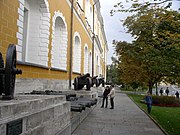
View of the Entrance to the Arsenal, by Canaletto, 1732.

Cannons and mortars of Napoleon's Army exhibited along the wall of the Kremlin Arsenal.
An arsenal is a place where arms and ammunition are made, maintained and repaired, stored, issued to authorized users, or any combination of those. Over the centuries, this has included every variant of such a place, whether privately or publicly owned (with the latter in older royal and modern state-owned versions). Armories and arsenals are both places where arms or ammunition may be made, maintained and repaired, stored, or issued. The usage differences between the names is mainly a matter of historical linguistic development. It is a common principle in natural language that synonyms have subtle connotative boundaries (albeit ones that may be somewhat permeable over time and distance).
Types[]
A lower-class arsenal, which can furnish the material and equipment of a small army, may contain a laboratory, gun and carriage factories, small-arms ammunition, small-arms, harness, saddlery tent and powder factories, and a powder factory; in addition it must possess great store-houses. In a second-class arsenal the factories would be replaced by workshops. The situation of an arsenal should be governed by strategic considerations. If of the first class, it should be situated at the base of operations and supply, secure from attack, not too near a frontier, and placed so as to draw in readily the resources of the country. The importance of a large arsenal is such that its defences would be on the scale of those of a large fortress.
Operational subdivision[]
The usual subdivision of branches in a great arsenal is into storekeeping, construction and administration. Under storekeeping we should have the following departments and stores: Departments of issue and receipt, pattern room, armoury department, ordnance or park, harness, saddlery and accoutrements, camp equipment, tools and instruments, engineer store, timber yard, breaking-up store, unserviceable store. Under construction: Gun factory, carriage factory, laboratory, small-arms factory, harness and tent factory, powder factory, etc. In a second-class arsenal there would be workshops instead of these factories. Administration: Under the head of administration would be classed as the chief director of the arsenal, officials military and civil, non-commissioned officers and military artificers, civilian foremen, workmen and laborers, with the clerks and writers necessary for the office work of the establishments.
In the manufacturing branches are required skill, and efficient and economical work, both executive and administrative; in the storekeeping part, good arrangement, great care, thorough knowledge of all warlike stores, both in their active and passive state, and scrupulous exactness in the custody, issue and receipt of stores. Frederick Taylor introduced command and control techniques to arsenals, including the U.S.'s Watertown Arsenal (a principal center for artillery design and manufacture) and Frankford Arsenal (a principal center for small arms ammunition design and manufacture).
See also[]
| Wikimedia Commons has media related to Arsenals. |
References[]
External links[]
| Look up arsenal in Wiktionary, the free dictionary. |
The original article can be found at Arsenal and the edit history here.